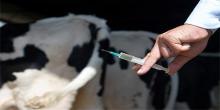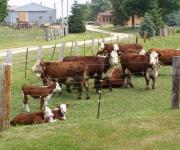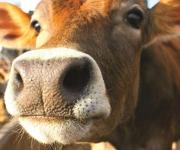FAO called for large-scale vaccination of cattle to contain nodular dermatitis in Eastern Europe and the Balkans, especially in areas where the risk is the highest.
This was reported by the press service of FAO.
FAO warned that even countries that have not been affected by the epidemic of this disease yet but are considered risk prone should be vaccinated to prevent the spread of a disease that could lead to devastating consequences for the farmer, especially for small farmers.
"Despite the fact that the outbreak in Europe was managed to be contained in April thanks to the massive vaccination, we see that the disease appears again in recent months in Albania, Greece and Macedonia. This is another warning sign that the disease is not completely destroyed yet and can continue to spread if we do not intensify efforts to control it, " says Ren Wang, FAO Deputy Director General for Agriculture and Consumer Protection.
FAO calls on governments in regions at risk to carry out vaccination campaigns, especially in the run-up to the seasonal insect attack, which usually begins in March, when infection rates are high, to prevent, control and eliminate diseases.
For example, preventive vaccination in Croatia, Bosnia and Herzegovina and northern Serbia has created a kind of buffer zone and would prevent this disease from potentially spreading to neighboring countries such as Hungary and Romania, where the disease was eliminated.
FAO warned that slaughter of infected farms should only be used as a last resort, since such measures could have a negative impact on the livelihoods of small farmers. If a bruise is considered a necessary measure, FAO recommends using it only if the animal infection is confirmed by an authorized laboratory and if the slaughter is carried out in a humane manner and the animal carcasses are properly disposed of.
FAO has already played an important role in assisting countries in adjusting policies in such a way that vaccination is used as the main measure to prevent nodular dermatitis and minimize slaughter.
"Despite the progress made in the fight against nodular dermatitis, there are still some gaps on which we need to focus. First, we need to better understand, for example, whether nodular dermatitis can be transmitted through contaminated milk from one animal to another, or can infected animals that do not show clinical signs, still spread the virus, " Wang has said.
"We also need to improve regional coordination and strengthen surveillance so that we can more effectively fight the spread of the disease," he has added.
At the same time, FAO supports countries in combating nodular dermatitis in the field. A template was created for the contingency plan, which countries can adapt to their circumstances and needs.
It bears reminding that nodular dermatitis is a smallpox virus, carried by insects, which can be fatal to livestock, but does not affect people's health. Previously, the disease was found only in Africa. In 2013, it appeared in Turkey, and then spread rapidly to nine countries in Eastern Europe and the Balkans. At the height of the spread of the disease in Europe, the affected countries registered up to 200 outbreaks, which resulted in significant economic losses as a result of a drop in milk production and a decrease in the quality of animal skin, as well as the death of about 15% of animals in affected flocks.
Англійська














 Лобіювання інтересів тваринників в органах виконавчої влади
Лобіювання інтересів тваринників в органах виконавчої влади Участь в науково-практичних заходах Асоціації із залученням європейських експертів світового рівня
Участь в науково-практичних заходах Асоціації із залученням європейських експертів світового рівня Щотижневий огляд тенденцій та прогнозів розвитку тваринницької галузі
Щотижневий огляд тенденцій та прогнозів розвитку тваринницької галузі